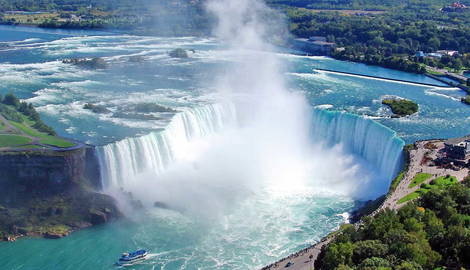
At the southern end of Niagara Gorge on a stretch of water flowing from Lake Erie to Lake Ontario, three waterfalls, known collectively as Niagara Falls, straddle the border between Canada and the United States. This natural wonder is a popular location for those wishing to see some of the beauty that the North American continent has to offer. Depending on the time of year, Niagara Falls offers different experiences for visitors.
Climate and Weather

Spring offers chilly weather for visitors. The mercury rises to a daily mean of 41°F to 66°F (around 5°C to 19°C) while the ice and cold water on Lake Erie can blow frosty wind around the falls, making the experience of visiting even colder. Snow is also very much on the cards until mid-April and camping is not advisable until after this period.
The summer months of June, July, and August is the most popular time to visit Niagara Falls. This is peak season and visitors are rewarded with pleasant weather. Daily highs are around 75ºF to 81°F (21°C to 25°C) and rainfall is sparse. Hot days are often tempered by cool breezes from the lakes where the water temperature is cooler than the air temperature.

In the Autumn, temperatures begin to drop again, and visitors can expect to experience daily high temperatures of 46°F to 72°F (8°C to 22°C) with the first frost and snow falls starting around the end of October or the beginning of November.
In the winter, from December to early March, Niagara Falls and the surrounding landscape becomes a frigid spectacle of sparkling ice and drifts of fresh snow. As expected, the temperature at this time reaches well below freezing. January is the coldest month with an average temperature of 24.6°F (−4.1°C) while December and February are almost as cold. In March the temperature starts to rise to a daily mean above freezing, yet snowfall is still frequent.
The Tourist Season

June to August is the busiest time to visit Niagara Falls. This period coincides with the hot summer months and all the subsidiary tourist attractions are open for business, including the Niagara SkyWheel, the Whirlpool AeroCar, hiking trails, and guided tours, providing plenty of activities for adventure-seeking enthusiasts. The Discover Niagara Shuttle operates during the summer and makes it easier to get from one attraction to the other. Summer is, however, also when hotels are the priciest!
Mid-October to early May is the off season and the crowds are substantially smaller, except for the time around the holidays from late December to early January. This is the time schools take a break, and family vacations are popular. Hotel prices are generally cheaper around this time, but the wintry conditions do mean, however, that many of the attractions are closed. In the shoulder season of late April to early May, the flowers are in bloom. This period is just after the Spring Break crowds have left and before the summer crowds arrive.
It is important to remember that Niagara Falls straddles the border between Canada and the United States. Many visitors will require visas for both countries if the plan is to see the falls from both sides. US and Canadian citizens should also have their passports with them.
Whatever time of year it is, Niagara Falls offers stunning views. Each season offers something different for visitors to enjoy, whether it’s taking a cruise, going on hiking trails, or enjoying the site from the safety of many of the indoor attractions.






